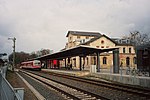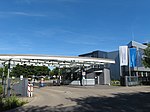Ostfalia University of Applied Sciences
Education in BraunschweigGermany university stubsUniversities and colleges established in 1971Universities and colleges in Lower SaxonyUniversities of Applied Sciences in Germany ... and 1 more
Wolfenbüttel

Ostfalia Hochschule für angewandte Wissenschaften (German for "Eastphalia University of Applied Sciences", known as Fachhochschule Braunschweig/Wolfenbüttel until 2009), is a Fachhochschule in eastern Lower Saxony, Germany. The predecessor of the college, Staatliche Ingenieurschule Wolfenbüttel (State Engineering School Wolfenbuettel), was founded in 1928. It merged with two other independent institutions in August 1971. It has campuses at: Salzgitter (SZ) Wolfenbüttel (WF) Wolfsburg (WOB) Suderburg (UE)
Excerpt from the Wikipedia article Ostfalia University of Applied Sciences (License: CC BY-SA 3.0, Authors, Images).Ostfalia University of Applied Sciences
Salzdahlumer Straße,
Geographical coordinates (GPS) Address Nearby Places Show on map
Geographical coordinates (GPS)
| Latitude | Longitude |
|---|---|
| N 52.176666666667 ° | E 10.548611111111 ° |
Address
A Hauptgebäude
Salzdahlumer Straße 46/48
38302 , Kurzes Holz
Lower Saxony, Germany
Open on Google Maps








